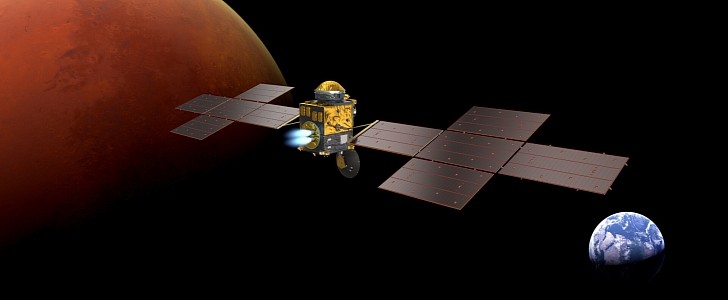By the end of the decade, NASA, together with the European Space Agency (ESA), will bring the first pieces of an alien world on the terrestrial ground. It will do it with the help of multiple robotic systems and spacecraft that will work together to collect and carry the precious cargo back to Earth. One of them is the Earth Return Orbiter (ERO), which will use the power of the Sun to travel through space.
Airbus used electric propulsion in space for the first time in the early 2000s to keep a fleet of telecommunications satellites in their right orbital positions above our planet. Since then, the company has improved the technology, and, in 2017, it used it to power a communications satellite that managed to consume six times less propellant than a counterpart with traditional chemical propulsion.
Airbus is now working on an all-electric system for the Mars Sample Return Mission, which is an international effort meant to return the first rock samples from the Red Planet. The company was selected by ESA in 2020 as a prime contractor for the development of the Earth Return Orbiter (ERO).
The six-meter (20-ft) tall spacecraft is expected to be launched in 2026. It will be equipped with massive solar panels spanning more than 40 meters (131 feet) and an electric propulsion system three times more powerful than that used for the BepiColombo, Europe's first mission to Mercury.
It will take around one year to get to the Red Planet. Once there, chemical propulsion will allow ERO to enter into a stable orbit around the planet. At 400 km (249 miles) above Mars' surface, it will rendezvous with a Mars Ascent Vehicle, which will carry an object no bigger than a basketball filled with fragments of the alien world.
This object, called the Orbiting Sample, will be transferred to the orbiter, which will safely carry it back to Earth for analysis. To return home, ERO will once again harness the power of the Sun. Until NASA and ESA kickstart the mission, Airbus will monitor the spacecraft development, which will take place in Toulouse, France.
Airbus is now working on an all-electric system for the Mars Sample Return Mission, which is an international effort meant to return the first rock samples from the Red Planet. The company was selected by ESA in 2020 as a prime contractor for the development of the Earth Return Orbiter (ERO).
The six-meter (20-ft) tall spacecraft is expected to be launched in 2026. It will be equipped with massive solar panels spanning more than 40 meters (131 feet) and an electric propulsion system three times more powerful than that used for the BepiColombo, Europe's first mission to Mercury.
It will take around one year to get to the Red Planet. Once there, chemical propulsion will allow ERO to enter into a stable orbit around the planet. At 400 km (249 miles) above Mars' surface, it will rendezvous with a Mars Ascent Vehicle, which will carry an object no bigger than a basketball filled with fragments of the alien world.
This object, called the Orbiting Sample, will be transferred to the orbiter, which will safely carry it back to Earth for analysis. To return home, ERO will once again harness the power of the Sun. Until NASA and ESA kickstart the mission, Airbus will monitor the spacecraft development, which will take place in Toulouse, France.







